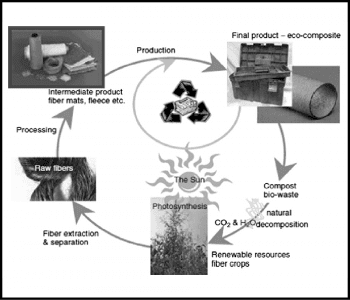Polymer composite materials are used in many different contexts, including the automotive, aerospace, and construction industries. Fiber-reinforced polymers offer improved mechanical properties over their non-reinforced counterparts, with increased hardness, better tensile, flexural, and impact strengths, and higher tensile modulus. The fibers within the polymer hold the plastic together, resisting deformation and breaking under stresses. The extent to which this is achieved depends on several factors, including the dimension (length and width) of the fibers, the density of the fibers within the polymer, and the strength of adhesion between the fiber and polymer, as well as defects and variation within the fibers themselves.

Owing to the vast quantities of fiber-reinforced polymers used in large-scale industrial applications, there are, naturally, concerns arising regarding their environmental impact. Petrochemical-based polymers present a range of environmental hazards during their production and require large quantities of oil—a dwindling resource—to produce. The fibers themselves, often made of glass and carbon, have their own production concerns. Aside from the environmental impact, the cost of the composite material is also an important factor, as glass and carbon fibers are relatively expensive to produce, and fluctuating oil prices mean unstable costs for the composite material as a whole. The cost and environmental concerns are driving the need for new materials that have similar mechanical properties but that are produced at a lower cost and made using more sustainable methods.
Such new materials come in the form of natural fiber-reinforced polymers, in which either the polymer or fiber materials, or both, are derived from renewable plant resources. The current status of natural fiber-reinforced polymers has been reviewed by researchers actively developing new composites. The obvious advantages of such composites are the low costs of bio-materials compared to petroleum-based plastics, glass, and carbon, and the renewable nature of the plant sources. Such composites are also lower density than traditional glass- or carbon-reinforced plastics. However, in order to replace some or all of the fiber-reinforced plastics currently used in industry, it must be ensured that the bio-based composites have appropriate mechanical properties.
Bio-polymers currently available include polymers derived from starch, sugar, vegetable oils, and soy. Such plastics are already in use in a variety of consumer applications; however, there are degradation concerns over their use in industrial applications, as many bio-polymers have a limited shelf life. Natural fibers for reinforcement currently in use with petroleum based plastics include fibers obtained from flax, hemp, kenaf, and sisal, although there are several other candidates for new natural fibers for such applications, including jute and coconut fibers. Natural fiber-reinforced petrochemical-based plastics are already being applied in the automotive industry, to produce various interior and non-structural components, including cup-holders, door panels, and trunk liners. Components such as bumpers, currently made from glass fiber composites, could instead be made of mixed natural and glass fiber composites, which have been shown to have similar or better mechanical properties. In general, most natural-fiber-only reinforced composites have slightly worse mechanical performance than those of traditional composites, but reducing the reliance on glass and carbon fiber composites by using hybrid fibers would still lead to significant reduction of costs and environmental impact.
As well as concerns over the longevity of bio-based polymers, the use of natural fibers for reinforcement, either in bio- or petroleum-based polymers, comes with its own set of issues regarding shelf-life. Natural fibers are susceptible to moisture, which will cause swelling and degradation of the fiber, and a reduction in performance. Degradation also leads to odor production, which is a serious issue for interior automotive components. Additionally, variability in the growth conditions leads to irregularities in natural fibers, which will also affect performance. Chemical treatments can reduce water absorption, and increase fiber consistency, and further improvements are sought via the use of various nanotechnology-based coatings.
Though much more work is yet to be done in order to achieve fully bio-based composite polymers for industrial applications, it is clear that this is a promising avenue for new, environmentally friendly technologies. The ecological and economic benefits offered by bio-based fibers and hybrid composites are driving a large body of research into development of appropriate processing and treatment techniques to obtain high-performance, durable, fiber-reinforced composites, in order to transform sustainable industry.
This article is part of the special Best of Macros–Edition 2015 issue, and is now free to read at http://www.best-of-macros.de!

















